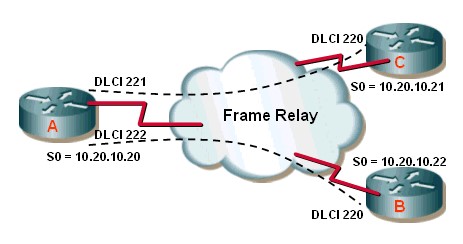The exhibit is a frame relay hub-and-spoke topology with router A as the hub.
You want to use the OSPF routing protocol between all three locations. Which interface configuration commands are required on router A? (Choose three.)
A. ip ospf network broadcast
B. ip ospf network point-to-point
C. ip ospf network point-to-multipoint
D. frame-relay map 10.20.10.21 221
E. frame-relay map 10.20.10.22 222
F. frame-relay map ip 10.20.10.21 221 broadcast
G. frame-relay map ip 10.20.10.22 222 broadcast
Explanation:
In OSPF point-to-multipoint mode, the routers will automatically identify each neighbor. The election of a designated router (DR) and backup designated router (BDR) are not required. This RFC compliant mode of operation is commonly found in partial mesh topologies, such as hub-and-spoke designs. In the diagram shown in the scenario, router A is the hub.
The frame relay serial interface has one DLCI to each spoke location. DLCI 221 is used by router A to communicate with router C and DLCI 222 is used to communicate with router B. On router A’s serial interface, point-to-multipoint mode is enabled with the ip ospf network configuration command. The following is the syntax of the ip ospf network command:
ip ospf network [{broadcast | nonbroadcast | point-to-multipoint | point-to-multipoint nonbroadcast}]
The command parameters are as follows:
• broadcast – This mode enables the interface to emulate a LAN. This mode requires a full or partial mesh topology.
• nonbroadcast – This RFC 2328 compliant mode is also referred to as NBMA mode. The neighbors must be statically configured.
• point-to-multipoint – This RFC 2328 compliant mode is used in partial mesh topologies, such as hub-and-spoke. Routers use additional LSAs to discover neighboring routers instead of manually defining DRs and BDRs. The hub router floods link state updates (LSUs) by duplicating the update to be sent to each routers using the respective DLCI.
• point-to-multipoint nonbroadcast – This is a Cisco extension to the point-to-multipoint mode.
This mode is useful when the frame relay virtual circuits do not support broadcast traffic. Neighbors are manually defined.
There is no point-to-point parameter for the ip ospf command. Creating a point-to-point configuration differs in that the point-to-point parameter is executed as a parameter of the command that creates the subinterface that hosts the point-to-point connection as shown below:
Router(config)# interface serial 0.1 point-to-point
When configuring a serial interface without sub-interfaces, OSPF will check the encapsulation to determine the network type. HDLC and PPP default to point-to-point while Frame-Relay encapsulation defaults to nonbroadcast.
The frame-relay map command identifies the mapping between the Layer 3 address (IP address) and the Layer 2 address (DLCI). The frame relay virtual circuits from the hub router are identified as supporting broadcast traffic by using the frame-relay map command with the broadcast keyword.
Objective:
Layer 2 Technologies
Sub-Objective:
Explain Frame Relay


